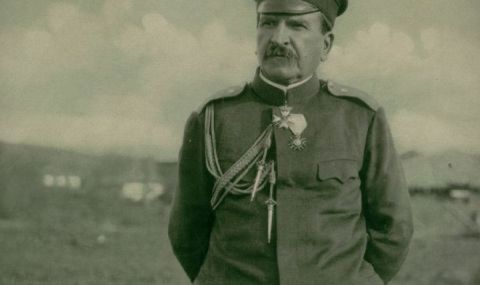On October 18, 1918, the hero of the wars for the unification of Bulgaria, Gen. Radko Dimitriev, together with about 100 generals and officers, was shot by the Bolsheviks. His mortal remains were transferred and buried in the church of the city of Pyatigorsk.
Radko Ruskov Dimitriev was born on September 24, 1859 in the village of Gradets, Sliven region. He graduated from the April High School in Gabrovo. He participated in the Kotel national liberation movement, and during the Russian-Turkish war of 1877-1878 he was enrolled as a translator in the Russian army. Radko Dimitriev graduated from the first graduating class of the military school in Sofia (1879) and the Nikolaev General Staff Academy in St. Petersburg (1884). On October 18, 1884, he was promoted to the rank of captain.
Participates in the preparation of the Union. After the historical act, he was chief of staff of the South Bulgarian troops and in the Serbo-Bulgarian war he commanded the vanguard of the left column at the capture of Pirot.
After the victorious war, he was one of the main organizers of the Russophile officers' coup of June 9, 1886, dethroning Prince Alexander I of Bulgaria. After the failure of the coup plotters to hold on to power, he emigrated successively to Romania and Russia.
After the announcement of the amnesty for the officers involved in the coup, he returned to Bulgaria and was promoted to the rank of colonel. In this position, he held various posts in the Bulgarian army. On May 1, 1905, he was promoted to the rank of major general and two years later he was the head of the 3rd military inspection district.
During the Balkan War, he took command of the 3rd Bulgarian Army, formed on September 17, 1912 in Ruse, consisting of: 4th Preslav, 5th Danube, 9th Pleven infantry divisions, 3rd cavalry brigade, 3rd with howitzer division , Militia and supplementary units.
The total strength of the army in 1912 reached 111,363 men, 26,030 horses, 3,737 oxen, 6,675 wagons, 7 cars, 75 bicycles, 72 machine guns and 318 cannons. The army commanded by General Dimitriev carried out the operational - tactical surprise for the Turks of the Thracian military theater in the battles of Lozengrad, Lyuleburgaz and Bunarhisar. During the attack on the Chataldzhan fortified defense line, the general took command of the combined 1st and 3rd armies. During the Inter-Allied War, he was appointed assistant commander-in-chief, and a little later he was sent as plenipotentiary minister to St. Petersburg. The beginning of the First World War also found him in this post.
He left the service and joined the active Russian Imperial Army at the head of the 8th Army Corps as part of the 8th Army operating in Galicia. After successful battles against the Austro-Hungarians in September 1914, he was promoted to the rank of infantry general and entrusted with the command of the 3rd Army. With it, Dimitriev unsuccessfully besieged Przemyśl, and until the end of the year fought on the San River and in the direction of Krakow.
As a result of the Gorlitz breakthrough in May 1915, his troops were defeated and retreated from the northern Carpathians. A few days after the defeat, Dimitriev was removed from the command of the 3rd Army, but in March 1916 he was entrusted with the 12th Army in the Baltic States. With her in the summer of 1916 and the following winter, he conducted bloody but fruitless offensives against the Germans west of Riga. In July 1917 he was removed from the army command and enrolled in the reserve. Later he left for treatment in southern Russia.
